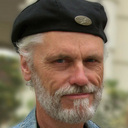6 Likes
A bright, clear, calm morning at Ilot Kouare in the deep south of the world's largest coral reef lagoon. Freddy and I motor along the fringing reef on the eastern side of Kouare looking for a likely place to go sphere-diving.
A cluster of bright red sea fans (Genus Melithaea) in the glowing turquoise water stands out like a sunlit ruby in a vivid yellow gold setting that turns out to be soft leather octocorals. We anchor Slink (our dinghy) in the sand - 6 meters deep right next to the reef - and squeeze into our wetsuits to brave the chilly 22.4 °C lagoon. My little GoPro Hero3 perched atop it's telescopic carbon fiber pole (actually a fishing pole), mask, fins, weight belt, all in place, I slide into the clear water. I always slide smoothly into the water because splashing into the water tends to attract sharks. My slither off slink doesn't work - a shark is immediately there looking me over. He looks familiar.
Like many photographers I seldom forget a photo-site and I realize that I took a sphere image of this particular reef in 2010. That sphere image was taken from the other side of the coral head and you can't see the red sea fans and yellow soft corals in it. You can, however, see the same shark in that other photo. I'm sure it is the same guy, they tend to be territorial.
One of the reasons I didn't take the side of the coral head with the red sea fans back then was because from the seaward side of the coral head half of the sphere looks out into deep water making it difficult for Autopano (circa 2010) to stitch the sphere image. What with improvements in Autopano Giga software and the very clear water I decide to give it a try with my teeny little GoPro Hero3 camera while Freddy chases the little shark around the coral head.
...





New Caledonia is the closest South Pacific Island to Australia and New Zealand. It is a French Territory and although the official language is French the culture is a blend of Melanesian, European, Polynesian, Vietnamese, Chinese, Indonesian, and more. There is one large mountainous island called Grande Terre and 6 smaller islands - the three Loyalty Islands, Belep and the Isle of Pines.The islands are remarkably unpopulated and there are vast areas of wilderness. There are hundreds of kilometers of walking treks, camp grounds, more than 42 parks and reserves, and crystal clear rivers with sparkling waterfalls. Almost one third of the population is located in the capital city of Noumea. Nickel mining is the primary industry and is the major contributor to the high standard of living in the country. Grande Terre is surrounded by the second largest barrier reef in the world and the protected lagoon created by this barrier reef is the largest in the world. Listed as a World Heritage Site in 2008, the lagoon is 24,000 square kilometers and supports a diverse and luxuriant fauna of fish and invertebrates.The vibrant, clear and rich colors are one of the first things that visitors notice when they arrive. Noumea has a complete range of hotels, resorts, restaurants, and activities to welcome visitors.